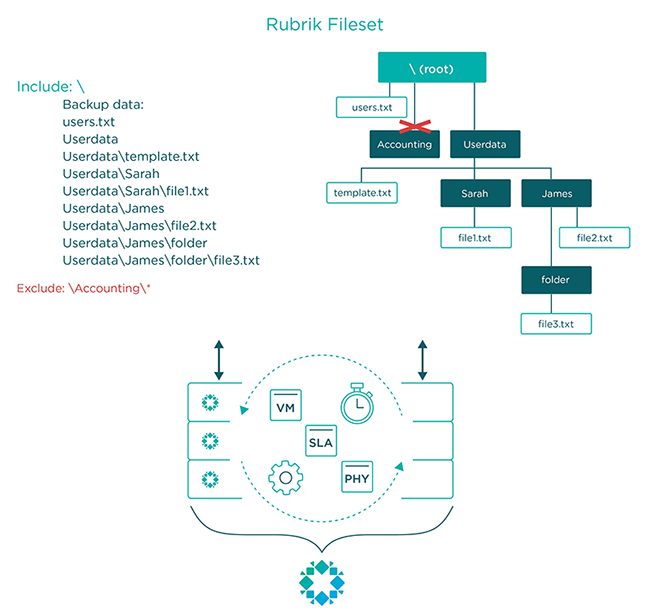As data continues to grow, supporting millions of files or more creates an increasing strain on backup and recovery environments. Traditional methods of backing up large data volumes can frequently consume precious server CPU and memory to the point of degraded application performance. At the point where application owners or internal customers cannot complete critical business tasks due to performance degradation, the data protection process can cause a negative financial impact. For example, a periodic traditional full backup may run for several hours, even during your entire production window, unable to capture a few critical files out of millions on your system. You may only need to recover a single file; the traditional backup application may not have protected it due to the inefficiencies of playing catch up from traversing large datasets.
Rubrik filesets deliver flexibility yet simplicity by empowering backup administrators with the granular ability to create logical sets of files and folders to include or exclude from protection. Whether you are maintaining Windows / Linux hosts or NAS shares, Rubrik filesets provide a simple and effective method to protect and recover at scale. Rubrik’s focus on incremental-forever plus universal fileset technology offers granular control, allowing a subset of data within a host to be protected, thus preserving server CPU and memory.
Rubrik filesets have multiple use cases, therefore acting as a universal fileset. The term universal applies to filesets, as various operating systems (Windows and Linux) and devices (NAS) are protected utilizing the fileset concept. Of course, there are similarities and unique differences with how Rubrik manages data from Windows, Linux, and NAS hosts; however, the similarities exist due to the way Rubrik utilizes filesets and how all of the action under the hood is abstracted from the user.
There are several questions to further clarify the point of using Rubrik filesets.
What is a Rubrik fileset? A fileset is a logical representation of a user-defined data path with inclusive and exclusive values. A fileset can also use full paths or filenames to define objects to include, exclude, or exempt from exclusion. The Rubrik cluster interprets the syntax entered for the inclusion or exclusion fields of filesets by following a relative path rule. In the case of NAS filesets, this means that after defining the share path, any associated filesets only need to include the desired path after the share.

Why should you use Rubrik filesets? The primary reason filesets are essential is to place the control in the hands of the user. Having power produces a sense of freedom, allowing users to fully customize values to include, exclude, or do not exclude.
How are Rubrik filesets used to protect large workloads? All of the heavy lifting is accomplished by the Rubrik cluster automatically via the fileset definitions under the hood. Rubrik has the intelligence to subdivide incoming datasets into 100 GB target partition sizes. Partitioning filesets into chunks provide increased ingest and restore performance as the workload distributes across all available nodes in the cluster. This distribution allows Rubrik to protect many files as a single fileset. Furthermore, filesets will continue to scale horizontally as more nodes join the Rubrik CDM platform. For NAS data, Rubrik has enhanced throughput for NFS as requests enter at the directory level instead of file level.
Rubrik filesets is a proven and critical tool that provides flexible protection with the power of granular-level backup and recovery. Without Rubrik filesets, backup administrators will continue to struggle with unsatisfactory backup performance, unacceptable recovery times, and legacy backup methods. Rubrik Filesets will equip you with a powerful way to customize your backups and optimize your recovery.
To learn more, read our blogs on Rubrik’s support for physical Linux and approach to backing up up NAS.
